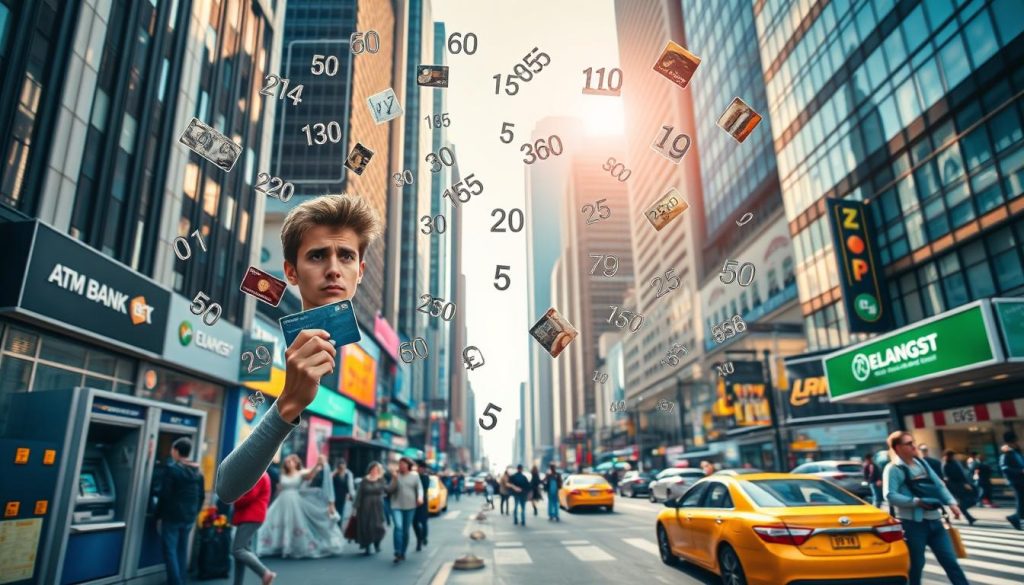Did you know that the Brazilian real has devalued by over 50% against the US dollar in recent decades? This fluctuation makes understanding the local currency essential for your trip. Whether you’re planning to explore bustling cities or serene beaches, knowing how to handle money can save you time and stress.
The Brazilian real is the official currency, and it’s widely used for everything from street vendors to high-end restaurants. While credit cards are accepted in most places, having cash on hand is crucial for smaller purchases and tipping. This guide will help you navigate payment methods, exchange rates, and budgeting tips to make your journey seamless.
Ready to dive into the details? Let’s ensure you’re fully prepared to handle money matters like a pro during your adventure.
Understanding the Brazilian Currency Landscape
The Brazilian real plays a pivotal role in shaping the country’s economic landscape. As the only legal tender, it drives local business and influences daily transactions. Whether you’re shopping in São Paulo or dining in Rio de Janeiro, understanding the currency system is essential for a smooth experience.
The Role of Currency in Brazil’s Economy
The Brazilian real is deeply tied to the nation’s economic stability. Introduced in 1994, it replaced the cruzeiro real and helped curb hyperinflation. Today, it operates under a floating exchange rate, meaning its value fluctuates based on market conditions. This system impacts everything from imports to tourism, making it a key factor for travelers.
Banks and ATMs are crucial for managing your money while traveling. They provide real-time exchange rates and ensure you have access to cash when needed. Major cities like Brasília and Salvador may have slight regional differences in transaction practices, so it’s wise to stay informed.
Key Features of the Brazilian Real
The Brazilian real is divided into 100 centavos, with banknotes ranging from R$2 to R$200. Coins are commonly used for smaller purchases, though the 1 centavo coin is rare. The Central Bank of Brazil oversees the currency, ensuring stability and efficiency in the financial system.
Understanding these features can help you navigate daily transactions with ease. From paying for public transport to dining out, the Brazilian real is your gateway to experiencing the local culture and economy.
Spotlight on the Brazilian Real: Denominations and History
Understanding the Brazilian real means diving into its denominations and rich history. This currency is not just a medium of exchange but a reflection of the nation’s economic journey. From its coins to banknotes, each piece tells a story of stability and progress.

Currency Denominations Overview
The Brazilian real is divided into coins and banknotes, each with unique designs and values. Coins range from 5 centavos to 1 real, while banknotes start at R$2 and go up to R$200. These denominations are widely used for everyday transactions, from public transport to shopping.
Here’s a quick breakdown of the current denominations:
| Type | Value | Key Features |
|---|---|---|
| Coins | 5, 10, 25, 50 centavos, 1 real | Durable, used for small purchases |
| Banknotes | R$2, R$5, R$10, R$20, R$50, R$100, R$200 | Color-coded, featuring historical figures |
Historical Evolution of the Brazilian Real
The Brazilian real was introduced in 1994 to replace the cruzeiro real and stabilize the economy. This change marked the end of hyperinflation and laid the foundation for growth. Over the years, the real has undergone design updates to enhance security and reflect cultural heritage.
Key milestones in its evolution include:
- 1994: Introduction of the real to combat inflation.
- 2000s: Introduction of polymer banknotes for durability.
- 2020: Launch of the R$200 note to meet modern demands.
Today, the real is a symbol of Brazil’s economic resilience. Whether you’re using an atm or paying with a card, understanding its history enriches your experience.
Navigating Currency Exchange Rates in Brazil
Currency exchange rates can make or break your travel budget, so understanding them is crucial. Whether you’re converting dollars to reais or tracking live rates, knowing the basics ensures you get the most value for your money. This section will guide you through mid-market rates, tracking tools, and practical tips for managing your cash effectively.
Understanding Mid-Market Exchange Rates
The mid-market rate is the benchmark used by banks and financial institutions for wholesale transactions. It’s the rate you see on financial news or currency websites, and it’s crucial for comparing the rates offered by exchange bureaus or ATMs. When converting your money, aiming for rates close to the mid-market ensures you’re not overpaying.
Banks and exchange bureaus often add a markup to this rate, which can vary significantly. For example, airport exchange desks typically offer poor rates due to high operational costs. Knowing this helps you choose the best option for your needs.
Tips to Track Live Rates
Tracking live exchange rates is easier than ever with online tools and apps. Websites like XE or Wise provide real-time updates, so you can monitor fluctuations and decide when to convert your money. Here are some actionable tips:
- Use reliable apps to check rates daily.
- Avoid exchanging money at airports or tourist hotspots.
- Compare rates from multiple sources before making a decision.
These tools empower you to make informed decisions and maximize your travel budget.
Bank vs. Exchange Bureau Rates
Banks and exchange bureaus often offer different rates, and understanding these differences can save you money. Banks usually provide rates closer to the mid-market but may charge additional fees. Exchange bureaus, on the other hand, might offer competitive rates but with higher markups.
Here’s a quick comparison:
| Option | Pros | Cons |
|---|---|---|
| Banks | Closer to mid-market rates, secure transactions | May charge fees, limited hours |
| Exchange Bureaus | Convenient locations, competitive rates | Higher markups, less transparency |
Practical Use of Coins and Banknotes
Once you’ve exchanged your money, understanding how to use coins and banknotes is essential. Coins are commonly used for small purchases like public transport or snacks, while banknotes are ideal for larger transactions. Knowing the denominations helps you handle daily expenses with ease.
For example, the R$2 and R$5 notes are perfect for tipping, while the R$50 and R$100 notes are better for shopping or dining. Being familiar with these details ensures a smooth experience during your trip.
Exchanging Money Before and During Your Trip
Getting the best value for your money starts with smart currency exchange decisions. Whether you’re planning ahead or handling transactions on the go, knowing your options can save you time and extra costs. Let’s explore the benefits of pre-trip exchanges and in-country options to help you manage your funds effectively.

Benefits of Pre-Trip Currency Exchange
Exchanging money before your trip offers several advantages. First, you can secure better rates compared to in-country options. Banks and online services often provide rates closer to the mid-market value, helping you avoid high markups. Second, you’ll have local currency ready upon arrival, reducing stress and ensuring you’re prepared for immediate expenses like transportation or meals.
Another perk is avoiding tourist traps. Airport exchange desks and popular tourist spots often charge higher fees. By planning ahead, you can sidestep these costly pitfalls and keep more money in your pocket.
In-Country Exchange Options and Tips
If you prefer to exchange money during your trip, ATMs and local exchange bureaus are your best bet. ATMs typically offer competitive rates, but be mindful of withdrawal fees. Local exchange desks can also provide good deals, especially if you compare rates beforehand.
Here are some tips to make the most of in-country exchanges:
- Use reliable travel apps to monitor live exchange rates and find the best deals.
- Avoid exchanging money at airports or tourist hotspots where fees are higher.
- Always carry a mix of cash and cards for flexibility.
Understanding the fees associated with currency exchange is crucial. Banks may charge transaction fees, while exchange bureaus often add markups. By comparing options and using apps, you can minimize these costs and maximize your travel budget.
Finally, ensure you have the correct amount of local currency upon arrival. Having smaller denominations is helpful for tipping and small purchases, while larger notes are ideal for shopping or dining. With these strategies, you’ll navigate currency exchange like a pro and enjoy a hassle-free trip.
Payment Options in Brazil: Using Cards and Cash
Managing your money while traveling is easier when you know your payment options. From credit and debit cards to cash, understanding when and where to use each can make your trip smoother. Let’s explore the best ways to handle transactions during your stay.
Using Credit and Debit Cards
Cards are widely accepted in major stores, restaurants, and hotels. Visa and Mastercard are the most common, making it easy to pay for meals, shopping, and accommodations. Using a debit card for ATM withdrawals is also convenient, especially in urban areas.
Modern technology makes managing your travel account seamless. Apps and online banking allow you to track spending and monitor transactions in real time. This helps you stay on budget and avoid surprises.
However, there are times when cash is preferred. Smaller vendors, local markets, and tipping often require physical currency. Having a mix of cards and cash ensures you’re prepared for any situation.
When to Use Cash
Cash is essential for smaller purchases and tipping. While cards are convenient, some places, especially in rural areas, may not accept them. Here are a few examples where cash is king:
- Street vendors and food stalls.
- Public transportation like buses and taxis.
- Tipping service staff at hotels or restaurants.
Ensuring You’re Charged in BRL
When using your card, always choose to be charged in the local currency (BRL). This avoids unnecessary conversion fees from your bank. For example, if a merchant offers to charge you in USD, decline and opt for BRL instead.
Safeguarding Your Cards and Banking Info
Traveling with cards requires extra caution. Here are some tips to keep your information secure:
- Use ATMs located inside banks or secure areas.
- Avoid sharing your PIN or card details with anyone.
- Notify your bank of your travel plans to prevent card blocks.
| Payment Method | Best Use Cases | Tips |
|---|---|---|
| Credit/Debit Cards | Major stores, restaurants, hotels | Choose BRL to avoid fees |
| Cash | Small vendors, public transport, tipping | Carry smaller denominations |
By understanding these payment options, you can navigate transactions with ease and enjoy a hassle-free trip.
Avoiding Dynamic Currency Conversion Pitfalls
Dynamic currency conversion (DCC) can sneak extra costs into your transactions if you’re not careful. This service allows merchants to charge you in your home currency instead of the local one. While it might seem convenient, it often comes with hidden fees and unfavorable exchange rates.

Identifying DCC at Merchants
Spotting DCC offers is crucial to avoiding unnecessary fees. When making a payment, you might see a prompt asking if you’d like to be charged in your home currency. This is a clear sign of DCC. Merchants in popular tourist cities often use this service to attract customers.
ATMs can also offer DCC during withdrawal transactions. Always check the screen for prompts and decline if given the option. Being vigilant helps you save money and avoid confusion.
How to Ensure You’re Charged in BRL
To avoid DCC, always insist on being charged in the local currency, Brazilian real (BRL). When using your card, decline any offers to convert the transaction to your home currency. This ensures you get the fairest exchange rate without added fees.
Here’s a quick guide to handling DCC:
| Situation | Action |
|---|---|
| Merchant offers DCC | Decline and request BRL |
| ATM prompts for DCC | Select local currency |
| Online payment with DCC | Choose BRL as the currency |
DCC often involves additional fees, which can vary depending on the business and the DCC service provider. These fees can add up quickly, especially during a longer trip. By opting for BRL, you avoid these unnecessary costs and keep your budget intact.
Understanding DCC and how to avoid it is essential for smart financial management during your travels. With these tips, you can navigate transactions confidently and save money along the way.
Essential Insights: Brazil: Ultimate Travelers Guide to Currencies & Payments
Smart financial decisions can make your trip smoother and more enjoyable. Whether you’re exchanging money or making payments, understanding the basics ensures you stay within budget and avoid unnecessary fees. Here’s a recap of the key takeaways to guide your financial decisions while traveling.
Key Takeaways for Smart Payment Decisions
Managing your money effectively starts with knowing your options. Here are the main lessons to keep in mind:
- Exchange rates matter: Always compare rates before converting your money. Avoid airport exchange desks, as they often charge higher fees.
- Use a mix of payment methods: Cards are convenient for larger purchases, while cash is essential for smaller transactions and tipping.
- Track live rates: Apps like Wise or Revolut provide real-time updates, helping you make informed decisions.
Another good idea is to carry smaller denominations of local currency. This makes it easier to pay for public transport, street vendors, and tips. Larger notes are better for shopping or dining.
When using cards, always choose to be charged in the local currency (BRL). This avoids dynamic currency conversion (DCC) fees, which can add up quickly. For example, if a merchant offers to charge you in USD, decline and opt for BRL instead.
Finally, prioritize security. Use ATMs located in secure areas, notify your bank of your travel plans, and avoid sharing your PIN or card details. These steps ensure your transactions are safe and hassle-free.
By following these tips, you’ll navigate payments like a pro and enjoy a seamless travel experience. Whether you’re using cash, cards, or travel apps, making smart choices is always a good idea.
Leveraging Travel Debit Cards for Hassle-Free Payments
Travel debit cards are a game-changer for managing money abroad, offering convenience and cost savings. They simplify multi-currency transactions, making it easier to pay for everything from meals to souvenirs. Whether you’re exploring bustling cities or serene beaches, these cards ensure you’re always prepared.
Advantages of Travel Debit Cards
Travel debit cards come with several benefits. First, they often have lower fees compared to traditional credit cards. This makes them a budget-friendly idea for frequent travelers. Second, they offer competitive exchange rates, ensuring you get more value for your money.
Another advantage is the ability to hold multiple currencies. This feature is perfect for trips to different places, as it eliminates the need for constant currency conversions. Plus, many travel debit cards provide real-time transaction tracking, helping you stay on budget.
Top Providers and Conversion Tips
When choosing a travel debit card, consider providers like Wise or Revolut. These companies are known for their low fees and user-friendly features. Here’s a quick comparison of their offerings:
| Provider | Key Features | Best For |
|---|---|---|
| Wise | Multi-currency accounts, low fees | Frequent travelers |
| Revolut | Real-time spending alerts, competitive rates | Tech-savvy users |
To make the most of your travel debit card, follow these tips:
- Always choose to be charged in the local currency to avoid dynamic currency conversion fees.
- Use ATMs in secure locations to withdraw cash safely.
- Notify your bank of your travel plans to prevent card blocks.
By leveraging these features, you can enjoy a seamless and cost-effective travel experience. Whether you’re dining out or shopping, travel debit cards are a smart idea for managing your money abroad.
Currency Exchange Strategies for Different Traveler Profiles
Your travel budget can stretch further with the right currency exchange strategy. Whether you’re a budget-conscious explorer or someone who values convenience, tailoring your approach ensures you get the most value. Here’s what you need to know to make smart financial decisions during your trip.
Strategies for Budget-Conscious Travelers
If you’re watching your spending, planning ahead is key. Exchanging money at home often offers better rates than in-country options. Banks and online services typically provide rates closer to the mid-market value, saving you from high markups.
Another way to save is by avoiding tourist hotspots for currency exchange. Airports and popular areas often charge inflated fees. Instead, use ATMs in secure locations or compare rates at local exchange bureaus.
Here are some actionable tips:
- Monitor live exchange rates using apps like Wise or Revolut.
- Carry a mix of cash and cards for flexibility.
- Always choose to be charged in the local currency to avoid extra fees.
Tailoring Your Exchange Approach
Your exchange strategy should align with your travel style. For example, if you prefer convenience, consider using travel debit cards. These cards offer competitive rates and allow you to hold multiple currencies, making them ideal for frequent travelers.
On the other hand, if you’re staying in one place for a while, exchanging a larger amount upfront can save time and effort. Just ensure you’re using a reliable service to avoid hidden fees.
Here’s a quick comparison of strategies:
| Traveler Profile | Best Strategy | Tips |
|---|---|---|
| Budget-Conscious | Exchange at home, avoid tourist traps | Use apps to track rates, carry smaller denominations |
| Convenience-Seeking | Use travel debit cards, exchange larger amounts | Choose multi-currency cards, notify your bank |
By understanding your needs and planning accordingly, you can make the most of your travel funds. Whether you’re exploring bustling cities or serene beaches, the right strategy ensures a smooth and cost-effective experience.
Essential Travel Tips Beyond Currency and Payments
Traveling to a new country involves more than just handling money; it’s about understanding local customs and staying safe. While managing your finances is crucial, knowing how to tip and protect your valuables can make your trip smoother and more enjoyable.

Tipping Etiquette and Local Practices
In many parts of the world, tipping is a way to show appreciation for good service. When traveling brazil, it’s helpful to know the local norms. In restaurants, a 10% service charge is often included in the bill, but adding a small extra amount is appreciated for exceptional service.
At hotels, tipping porters and housekeeping staff is common. A small amount, like R$5, is a polite gesture. For taxi drivers, rounding up the fare is usually sufficient. Understanding these practices helps you blend in and show respect for local culture.
Staying Secure With Your Cards and Cash
Keeping your money safe is just as important as managing it. When traveling brazil, avoid carrying large amounts of cash. Use a mix of cards and smaller denominations for daily expenses. This reduces the risk of loss or theft.
Always note the location of ATMs in secure areas, like inside banks. Avoid using public Wi-Fi for banking transactions, as it can expose your information to hackers. Notify your bank of your travel plans to prevent card blocks and ensure seamless access to your funds.
Here are some additional safety tips:
- Keep your cards and cash in separate places to minimize loss.
- Use a money belt or hidden pouch for extra security.
- Regularly check your accounts for any unauthorized transactions.
By following these guidelines, you can focus on enjoying your trip without worrying about financial mishaps. Whether you’re exploring bustling cities or serene beaches, staying informed and prepared is the key to a hassle-free experience.
Conclusion
Planning your finances wisely can make a significant difference in your travel experience. Monitoring the exchange rate before and during your trip ensures you get the best value for your money. Taking the time to compare rates and plan ahead can save you from unnecessary fees and stress.
Using a mix of payment methods is key. While cards are convenient for larger purchases, having cash, even down to the smallest centavo, is essential for smaller transactions and tipping. This balance ensures you’re prepared for any situation.
Staying informed about local currency practices helps you navigate payments smoothly. Whether you’re using an ATM or paying with a card, understanding the process makes your trip hassle-free. By planning ahead and staying alert, you can enjoy a rewarding travel experience without financial worries.
The above is subject to change.
Check back often to TRAVEL.COM for the latest travel tips and deals.
Here are some Tours & Sightseeing suggestions that might pique your interests!






